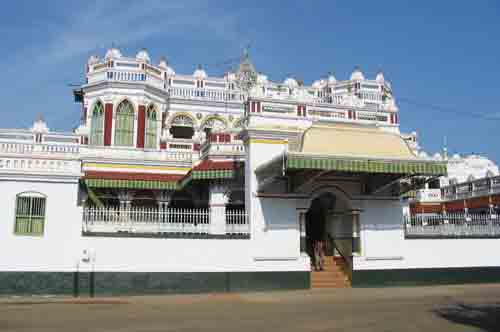Chettinad Palace

Information on Chettinad Palace (Chettinad, Tamil Nadu) - History & Architecture
Chettinaad Palace is one of the most splendid specimens of regal mansions of India. It is a beautiful fort located in Chettinaad of Tamil Nadu. The palace is regarded as a treasure troves of architectural specifics which replicate the urge of art and craft. Chettinaad Palace is also reputed for its use various materials which arrived from numerous nations of Asia and Europe.
Chettinad Palace Architecture
Chettinaad Palace replicate traditional architecture having rich cultural heritage. The palace is famous for its construction which is embroidered with marble and Burma teak. Chettinaad Palace has extensive courtyards and expansive rooms. The palace is covered with tiles, having small two storeyed tower. The towers were later expanded precipitously into two storeyed constructions with the addition of various galleries and yards that could house visitors during weddings and other rituals. Legends says that the walls of the palace used to be polished with a cream which was created from egg whites that help to provide a charming touch. Furthermore, it was also said that a regular pin can be easily found in the internal yard's tiled floor.
The inner decoration objects of Chettinaad Palace was derived from various nations. For example, the building ingredients, decorative objects and fixtures of Chettinaad Palace were typically bought from East Asian nations and from Europe. Furthermore, the marble used in the palace was imported from Italy, chandeliers was brought from Burma, tableware from Indonesia and wall-to-wall glasses from Belgium. The carpentry as well as masonry of Chettinaad Palace was stimulated by the forts of France and other European nations.
The most important feature of the architecture of Chettinaad Palace was native combination of traditional Indian architecture and various European elegances which changed over decades. The motivation for the design of Chettinaad Palace was derived from trade, travel and tradition.
Chettinad Palace History
There is no such historical incidents that are related with the creation of Chettinaad Palace. Originally, the palace was developed by Annamali Chettiyar in the year 1912. He was the founder of Indian bank as well as Annamalai University. The culture of Chettinaad reflect from the design of the palace.
According to historical records, the people of Chettinaad were encouraged and often bidden by the king due to their skills in craftsmanship. Chettinaad area was also considered as a centre of artistry in working on woods, brass, silver and other materials. Thus, they were in great demand, particularly for construction or makeover of any forts or palaces. Furthermore, the region, Chetinaad was advantageously positioned on traditional trade direction, making it accessible for the people to take prominent part in business and commerce with overseas nations such as Burma, Indonesia and other European states. Hence, the construction of Chettinaad Palace demonstrate materials which are imported from abroad. Furthermore, Chettinaad Palace is also regarded as the specimen of fine craftsmanship of the people of Chettinaad region.
Chettinad Palace Tourism Importance
Characterised by its beautiful architecture and exclusive design, Chettinaad Palace can be termed as a great place for tourism. It can evoke strong cultural feeling among travellers. The walls of the palace which are decorated with unique paste is extensively famed and is regarded as great tourist attraction. Furthermore, the decoration of the palace has certain universal appeal which can be enjoyed by tourists. The palace's attractive flourishes such as tiles and pillars among others cannot be observed in any other parts of India.
- Andaman Nicobar Monuments
- Andhra Pradesh Monuments
- Assam Monuments
- Bihar Monuments
- Chhattisgarh Monuments
- New Delhi Monuments
- Goa Monuments
- Gujarat Monuments
- Haryana Monuments
- Himachal Pradesh Monuments
- Jammu and Kashmir Monuments
- Karnataka Monuments
- Kerala Monuments
- Madhya Pradesh Monuments
- Maharashtra Monuments
- Odisha Monuments
- Punjab Monuments
- Rajasthan Monuments
- Tamil Nadu Monuments
- Telangana Monuments
- Uttar Pradesh Monuments
- West Bengal Monuments